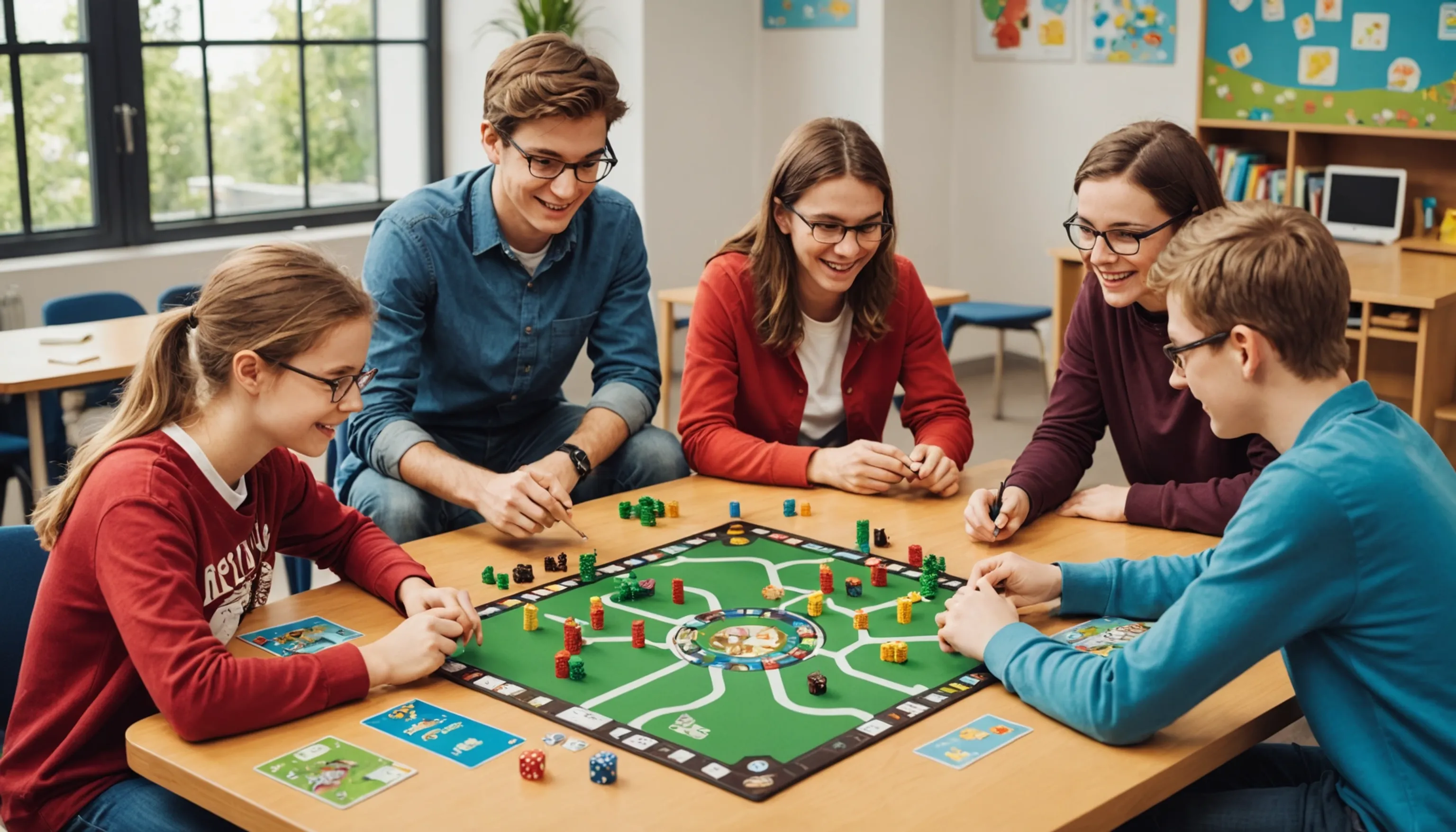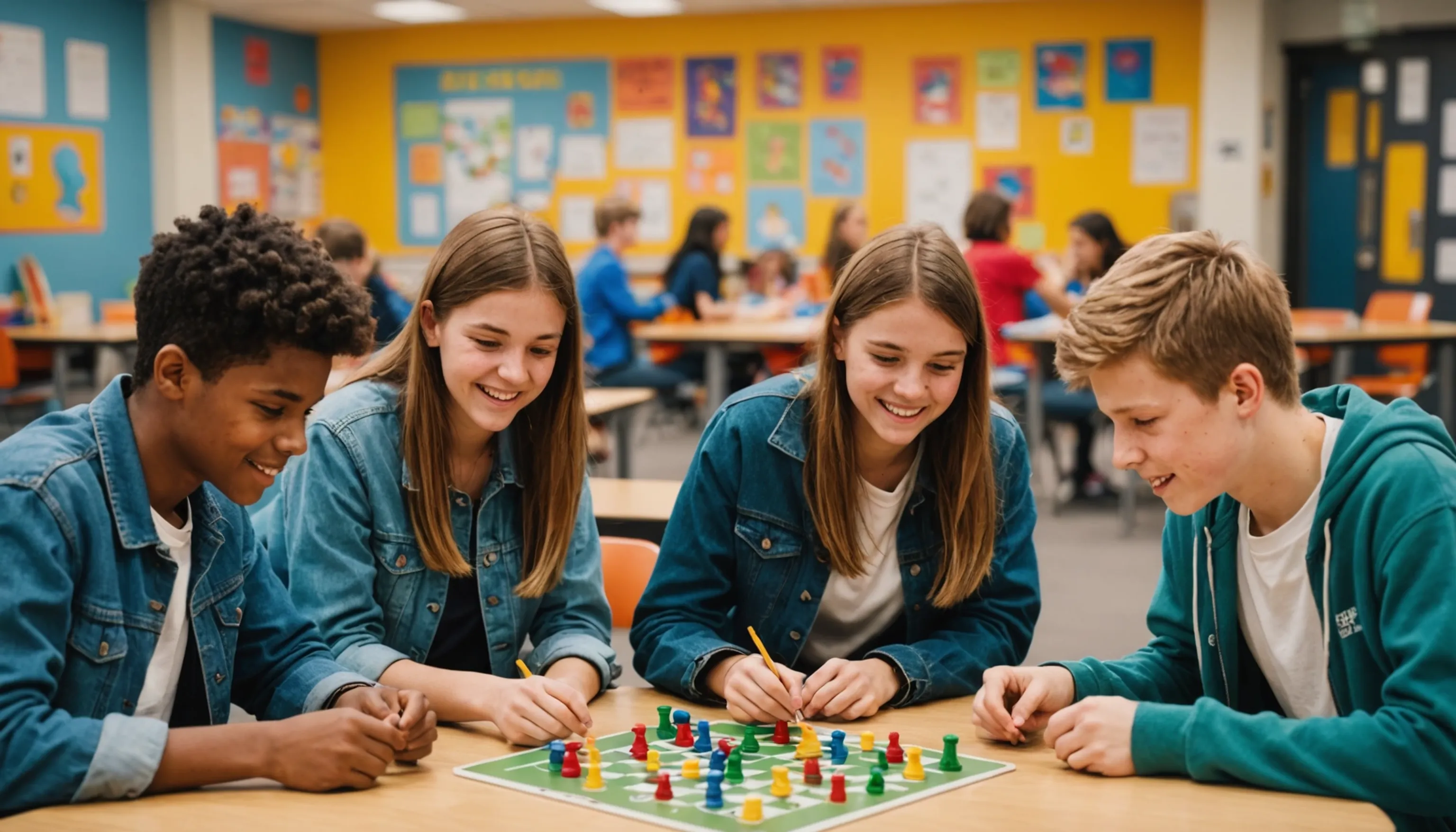The Great Future of Learning Games
 HvWHenry van Wagenberg
HvWHenry van Wagenberg
The Great Future of Learning Games
The future of learning games is incredibly promising, especially for teenagers. As technology advances, educational games are becoming more interactive, engaging, and tailored to individual learning styles. These games not only make learning fun but also help develop essential skills such as problem-solving and collaboration.
With the rise of digital platforms, students can access a vast array of educational games anytime, anywhere. This flexibility encourages self-directed learning and can significantly enhance academic performance. As educators and parents embrace this trend, learning games are set to revolutionize the educational landscape.
Benefits of Learning Games for Teenagers
Learning games offer a multitude of benefits for teenagers, making them a valuable tool in education. One of the primary advantages is enhanced engagement. Traditional teaching methods can sometimes fail to capture a teenager's attention, but games create an interactive environment that motivates students to participate actively in their learning process.
Moreover, learning games help develop critical skills essential for future success. Through gameplay, teenagers can improve their problem-solving abilities by facing challenges that require strategic thinking and decision-making. Many games encourage teamwork, fostering collaboration among peers and teaching important social skills.
Another significant benefit is the opportunity for personalized learning. Many digital learning games adapt to the player's skill level, providing tailored challenges that match individual needs. This adaptability helps ensure that each teenager can progress at their own pace, promoting a deeper understanding of the subject matter.
Learning games also promote a positive attitude towards education. When teenagers associate learning with fun and enjoyment, they are more likely to develop a lifelong love for knowledge. Additionally, these games often incorporate immediate feedback, allowing players to learn from their mistakes and improve continuously.
Finally, learning games can bridge the gap between different learning styles. Whether a teenager is a visual, auditory, or kinesthetic learner, there are games designed to cater to various preferences. This inclusivity makes educational games an essential resource for diverse classrooms.
How Learning Games Enhance Critical Thinking
Learning games play a crucial role in enhancing critical thinking skills among teenagers. These games often present players with complex scenarios that require thoughtful analysis and strategic decision-making. By engaging with these challenges, teenagers learn to evaluate situations from multiple perspectives and consider various outcomes before making decisions.
One significant aspect of learning games is that they encourage players to solve problems creatively. Unlike traditional educational methods that may promote rote memorization, games often require players to think outside the box. For instance, puzzle-based games compel players to identify patterns, make connections, and devise innovative solutions, all of which are fundamental components of critical thinking.
Additionally, many learning games involve collaboration, where teenagers must work together to achieve a common goal. This teamwork fosters communication skills and helps them articulate their thoughts and reasoning effectively. As they discuss strategies and analyze game mechanics with peers, they refine their ability to think critically while considering differing viewpoints.
Moreover, learning games often incorporate elements of trial and error. Players learn that failure is part of the learning process, prompting them to reassess their strategies and approach problems differently. This resilience is an essential characteristic of a critical thinker.
In conclusion, by integrating learning games into education, we can cultivate teenagers' critical thinking skills, preparing them for the complexities of the real world. These games not only make learning enjoyable but also equip students with the cognitive tools necessary for success.

Engagement and Motivation through Learning Games
Engagement and motivation are vital components of effective learning, and learning games excel in fostering these elements among teenagers. One of the primary reasons learning games are so engaging is their interactive nature. Unlike traditional classroom settings, games create dynamic environments where students can participate actively, leading to increased attention and interest in the subject matter.
Learning games often incorporate elements of competition and achievement, which can significantly boost motivation. When teenagers are presented with challenges and rewards, they naturally feel compelled to perform better. Achievements, such as leveling up or earning badges, provide tangible evidence of progress, reinforcing their desire to continue learning.
Moreover, learning games allow for autonomy in learning. Teenagers can choose their paths, make decisions, and explore various outcomes, fostering a sense of ownership over their education. This autonomy not only enhances their engagement but also builds self-confidence as they navigate challenges independently.
Another critical aspect is the immediate feedback provided by learning games. Players receive instant responses to their actions, helping them understand the consequences of their decisions. This real-time feedback loop encourages teenagers to reflect on their strategies and adjust their approach, further enhancing their learning experience.
Finally, the social interaction that often accompanies learning games cannot be overlooked. Playing with peers promotes collaboration and communication, making the learning process more enjoyable. When teenagers engage with their friends while learning, it creates a positive atmosphere that motivates them to participate actively and develop a genuine interest in the subject matter.
Types of Learning Games for Teens
There are various types of learning games designed specifically for teenagers, catering to different interests and learning styles. Digital learning games, such as educational apps and online platforms, offer interactive experiences that make learning fun. Board games that teach, like Scrabble or Catan, promote critical thinking and strategy while encouraging social interaction.
Gamified learning experiences combine traditional education with game mechanics, motivating students to engage with the material. Role-playing games (RPGs) can also enhance creativity and storytelling skills. By exploring these diverse options, educators and parents can find the perfect fit for their teens.
Digital Learning Games
Digital learning games are a rapidly growing segment of educational tools designed to engage teenagers in a fun and interactive way. These games leverage technology to create immersive environments where students can explore concepts and practice skills through gameplay. They range from simple quizzes and puzzles to complex simulations that mimic real-world scenarios.
One of the key advantages of digital learning games is their adaptability. Many of these games adjust their difficulty levels based on the player’s performance, allowing for personalized learning experiences. This ensures that each teenager can progress at their own pace, making the learning process more effective and enjoyable.
Additionally, digital learning games often incorporate elements of storytelling, which can significantly enhance engagement. By immersing players in captivating narratives, these games encourage them to think critically and creatively as they navigate challenges. For instance, history-themed games may allow students to experience significant events from different perspectives, deepening their understanding of the subject.
Furthermore, digital learning games offer instant feedback, enabling teenagers to learn from their mistakes in real time. This immediate response fosters a growth mindset, encouraging players to improve their strategies and approaches continuously.
Access to digital learning games is also a significant advantage. With smartphones, tablets, and computers widely available, students can engage with educational content anytime and anywhere. This flexibility promotes self-directed learning, empowering teenagers to take charge of their education.

Board Games that Teach
Board games that teach provide a unique and engaging way for teenagers to learn essential skills while having fun. These games often incorporate educational elements seamlessly into gameplay, making learning an enjoyable experience. Here are some popular types of board games that can enhance learning:
- Strategy Games: Games like Catan and Risk require players to think critically, plan ahead, and make strategic decisions, promoting problem-solving skills.
- Word Games: Games such as Scrabble and Boggle enhance vocabulary and spelling skills, encouraging players to think creatively with language.
- Math Games: Games like Monopoly and Prime Climb teach essential math concepts through real-life scenarios, helping players improve their numerical skills.
- History and Geography Games: Games such as Timeline and Ticket to Ride introduce players to historical events and geographical concepts, promoting knowledge retention through engaging gameplay.
In addition to providing educational value, board games also promote social interaction among peers. Playing games together encourages teamwork and communication, which are vital skills in both academic and real-world settings. Furthermore, board games can be easily integrated into family time, allowing parents to engage with their teenagers in a fun and constructive manner.
Overall, board games that teach serve as a fantastic resource for educators and parents looking to enhance learning in a relaxed and enjoyable environment.
Gamified Learning Experiences
Gamified learning experiences are innovative educational approaches that incorporate game elements into traditional learning environments. This method transforms the learning process into an engaging, interactive experience, motivating teenagers to participate actively in their education. By integrating game mechanics, educators can enhance student engagement and retention of knowledge.
Key components of gamified learning include:
- Point Systems: Students earn points for completing tasks, participating in discussions, or mastering concepts. This incentivizes them to put in more effort and track their progress.
- Badges and Achievements: Recognizing students with badges or certificates for reaching specific milestones fosters a sense of accomplishment and encourages friendly competition.
- Leaderboards: Displaying rankings among peers promotes a competitive spirit, motivating students to improve their performance while encouraging collaboration.
- Storytelling: Many gamified experiences utilize narratives to create immersive learning environments. By framing lessons within a story, students are more likely to connect emotionally with the material.
Gamified learning also allows for immediate feedback, enabling students to understand their strengths and areas for improvement. This real-time response encourages a growth mindset and helps teenagers develop resilience as they navigate challenges.
Moreover, gamified experiences can cater to various learning styles, making education more inclusive. Whether through digital platforms, classroom activities, or interactive projects, gamification enhances the learning experience by making it more dynamic and enjoyable. By embracing gamified learning, educators can equip teenagers with the skills they need to thrive in the modern world.
The Role of Parents and Teachers in Learning Games
Parents and teachers play a crucial role in integrating learning games into teenagers' education. They can introduce various educational games that align with curriculum goals, making learning more enjoyable. By actively participating in these games, parents and teachers can model positive attitudes toward learning and encourage collaboration among students.
Additionally, they can provide guidance and support, helping teenagers choose games that match their interests and learning styles. By fostering a game-based learning environment, parents and teachers can enhance motivation, engagement, and critical thinking skills, ultimately leading to a more enriching educational experience.
Encouraging Game-Based Learning at Home
Encouraging game-based learning at home can significantly enhance teenagers' educational experiences while making learning enjoyable. Here are several effective strategies for parents to foster this approach:
- Introduce Educational Games: Start by selecting a range of educational games that align with your teenager's interests and educational needs. Digital games, board games, and card games can all provide valuable learning opportunities.
- Set Aside Game Time: Designate specific times for family game nights or solo play sessions. This routine not only promotes learning but also strengthens family bonds.
- Encourage Discussion: After playing, engage your teenager in discussions about the game. Ask questions about strategies, decisions made, and what they learned. This reflection helps reinforce the skills developed during gameplay.
- Incorporate Learning Goals: Set specific learning objectives related to the games played. For example, if playing a math-based game, aim to improve problem-solving skills or speed in calculations.
- Celebrate Achievements: Recognize and celebrate milestones achieved during gameplay, whether it’s mastering a new concept or completing a challenging level. This positive reinforcement boosts motivation.
Furthermore, embrace a flexible attitude toward learning. Allow your teenager to explore different types of games, fostering creativity and self-directed learning. By creating a supportive environment for game-based learning, parents can help teenagers develop critical thinking, collaboration, and problem-solving skills that are essential for their future success.
Integrating Learning Games into the Classroom
Integrating learning games into the classroom can transform traditional teaching methods and create an engaging learning environment for teenagers. Here are several effective strategies educators can employ:
- Identify Learning Objectives: Start by aligning games with specific curriculum goals. Determine what skills or concepts you want to reinforce through gameplay, ensuring that the games chosen are educationally relevant.
- Incorporate Variety: Utilize a mix of digital and board games to cater to different learning styles. Digital platforms can offer interactive experiences, while board games foster teamwork and social interaction.
- Facilitate Team-Based Play: Encourage collaboration by organizing students into teams. This promotes communication, teamwork, and problem-solving skills, as students must work together to achieve common goals.
- Reflect on Gameplay: After playing, hold discussions or reflections to help students process what they learned. Ask questions about strategies used, challenges faced, and how the game relates to the subject matter.
- Monitor Progress: Use assessments to track students’ progress and understanding of the material. This can include quizzes, group discussions, or individual reflections on the gameplay experience.
Additionally, foster a positive classroom culture that values play as a legitimate learning tool. Encourage students to share their insights and experiences, creating an inclusive environment where everyone feels comfortable participating. By thoughtfully integrating learning games into the classroom, educators can enhance engagement, motivation, and critical thinking skills among teenagers, making learning both enjoyable and effective.
Choosing the Right Learning Games
Choosing the right learning games for teenagers is essential to maximize their educational benefits while ensuring engagement and enjoyment. Here are some key considerations to help parents and educators make informed decisions:
- Identify Learning Goals: Begin by determining the specific skills or concepts you want to reinforce. Whether it's math, language arts, or critical thinking, selecting games that align with these objectives will enhance their educational value.
- Consider Age Appropriateness: Ensure that the games are suitable for the age and developmental level of your teenager. Games that are too easy may lead to boredom, while overly complex games can cause frustration.
- Check Reviews and Recommendations: Look for reviews from other parents, educators, or trusted sources. Websites and forums dedicated to educational resources can provide valuable insights into the effectiveness and enjoyment of various games.
- Test for Engagement: Whenever possible, try out the games yourself or observe your teenager playing. Assess whether the game keeps their attention and encourages active participation. Games that spark curiosity and enthusiasm are more likely to be successful in the long run.
- Encourage Variety: Offer a diverse selection of games that cater to different interests and learning styles. This variety can include digital games, board games, and role-playing games, ensuring there’s something for everyone.
By thoughtfully choosing the right learning games, parents and educators can create an enriching educational experience that not only enhances knowledge but also fosters a love for learning among teenagers.
